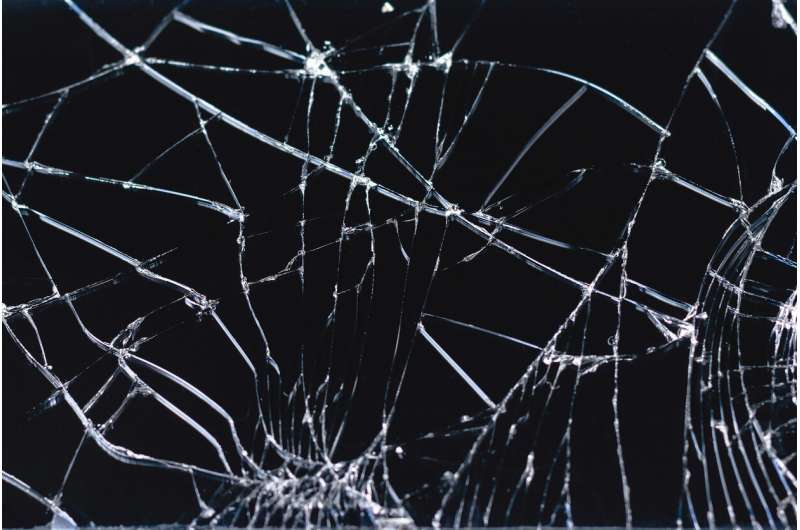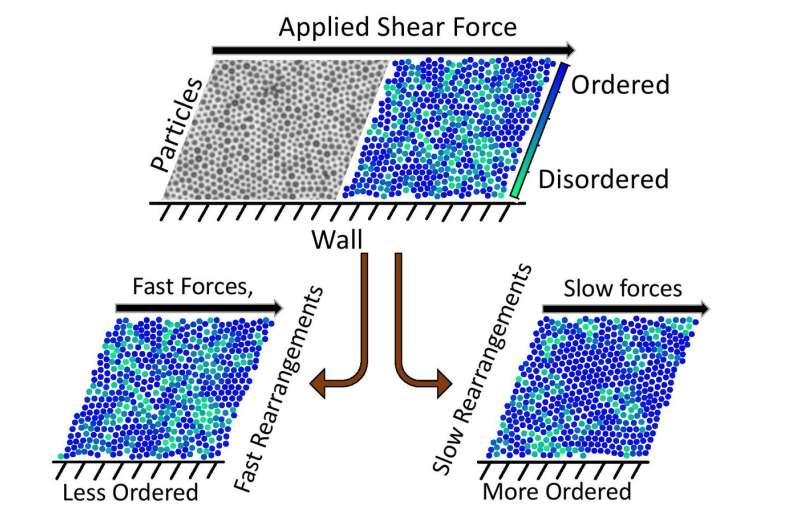Disordered materials, such as the glass used in smartphone screens, have many useful properties but are fragile if dropped or crushed. New research describes how external forces drive the rearrangement of individual particles in this class of materials. This fundamental finding could enable new ways to imbue materials with unique mechanical properties—like a phone screen that won’t shatter, for example. Credit: University of Pennsylvania
New research published in the Proceedings of the National Academy of Sciences describes how external forces drive the rearrangement of individual particles and shape microlevel structures in disordered materials. The study, conducted by graduate student Larry Galloway, postdoc Xiaoguang Ma, and faculty members Paulo Arratia, Douglas Jerolmack, and Arjun Yodh, provides new insights into how the microscopic structure of disordered, glass-like solids is related to external stressors and the resulting shifts in the motions of individual particles. These findings provide potential new approaches for creating customizable materials that have unique mechanical properties.
Throughout history, people have looked for ways to make materials more resilient, flexible, and durable, whether it be Damascus steel swords or vulcanized rubber. Nowadays, state-of-the-art imaging technologies allow scientists to study materials at the atomic level, but even with this enhanced resolution it remains a challenge to study materials when they are under external forces. This makes it difficult to develop "bottom-up" design approaches that can imbue materials with specified mechanical properties.
One class of materials that are particularly challenging, both to study and to manipulate, is disordered materials. Unlike ordered materials, which have crystalline structures with atoms in well-defined predictable locations, like on a honeycomb lattice, the atoms in disordered materials are arranged randomly, like grains in a pile of sand. Disordered materials, such as the glass used in smartphone screens, have many useful properties but are fragile if dropped or crushed.
To better understand how disordered materials could be modified in a way that gives them new properties, the researchers studied them during plastic deformation. This process, where the material is driven to flow and the atoms, molecules, or particles that make up the material can easily slip past one another, causes permanent rearrangements in the material's overall structure. The researchers' goal was to look for quantifiable relationships connecting a material's ability to change under the influence of external stress to how the individual particles rearrange.
The team conducted experiments using a "model" disordered material made of 50,000 colloidal particles designed to mimic atoms. The individual "atoms" were spread thinly across a water interface, and the researchers used a small magnetic needle to push the layer of atoms with a shearing force, causing them to flow along specific paths. Using video collected during the shearing process, they were able to track the movements of all 50,000 particles.
A diagram of the experimental design and results. A shearing force was applied to particles (shown in gray). The researchers found that the speed of the external force being applied was related to how ordered the final material became. Credit: Larry Galloway
Using this dataset, the researchers calculated two quantities that turned out to be crucial for understanding the disordered solid's response: excess entropy and relaxation time. Excess entropy is a measure of the overall sample structure that characterizes how disordered the material is. Particle relaxation is a measure of a material's response dynamics and characterizes how quickly individual particles move past one another.
"We noticed that these two quantities relate really nicely to each other," Galloway says about the analysis of this dataset, which the researchers used to quantify how quickly the colloidal "atoms" move past one another when a stress is applied and to compare that rate to how disordered the final material became.
The concept of excess entropy had previously been used to study liquids and systems that are in equilibrium, meaning that all of the forces acting on a system are in balance. The present work is the first experiment to apply these ideas to systems that are out of equilibrium, such as the plastically deforming disordered material studied here. "We found that the same concept, excess entropy, often utilized in the standard theory of liquids, could help us understand how solids deform plastically," says Ma.
By quantifying the relationship between structure, or excess entropy, and dynamics, or relaxation time, during plastic deformation, the team identified a connection between the shifts in the location of individual particles and the material's overall structure. "First, we applied an external stress to push the material," Yodh says. "Then, the particles in the material material rearranged and ultimately relaxed into a new internal structure. We discovered that the faster this external force is applied, the faster the particles rearrange and the more disordered the final material structure becomes, as reflected by its excess entropy."
This improved understanding of how a material's dynamics relates to its microstructure at the single-particle level can now help materials scientists understand the "history" of a given material. "If I know the rate of plastic deformation, then I can predict the amount of order of the material in its final state. Alternatively, if you look at a material and measure its microstructural order, then I can tell you something about the plastic deformation process that drove it there," says Ma.
The researchers are now planning additional experiments to calculate excess entropy more locally and to look at systems that are even more disordered than that used in this experiment. If they find that the physical principles established in the present work can be generalized to other types of materials, it could pave the way for new approaches relating atomic-level measurements to desirable mechanical properties. "Then, you could learn how to prepare a material in a certain way, by shearing faster or slower, such that you have a screen that doesn't shatter," says Arratia.
More information: K. Lawrence Galloway et al. Scaling of relaxation and excess entropy in plastically deformed amorphous solids, Proceedings of the National Academy of Sciences (2020). DOI: 10.1073/pnas.2000698117
Journal information: Proceedings of the National Academy of Sciences
Provided by University of Pennsylvania

























